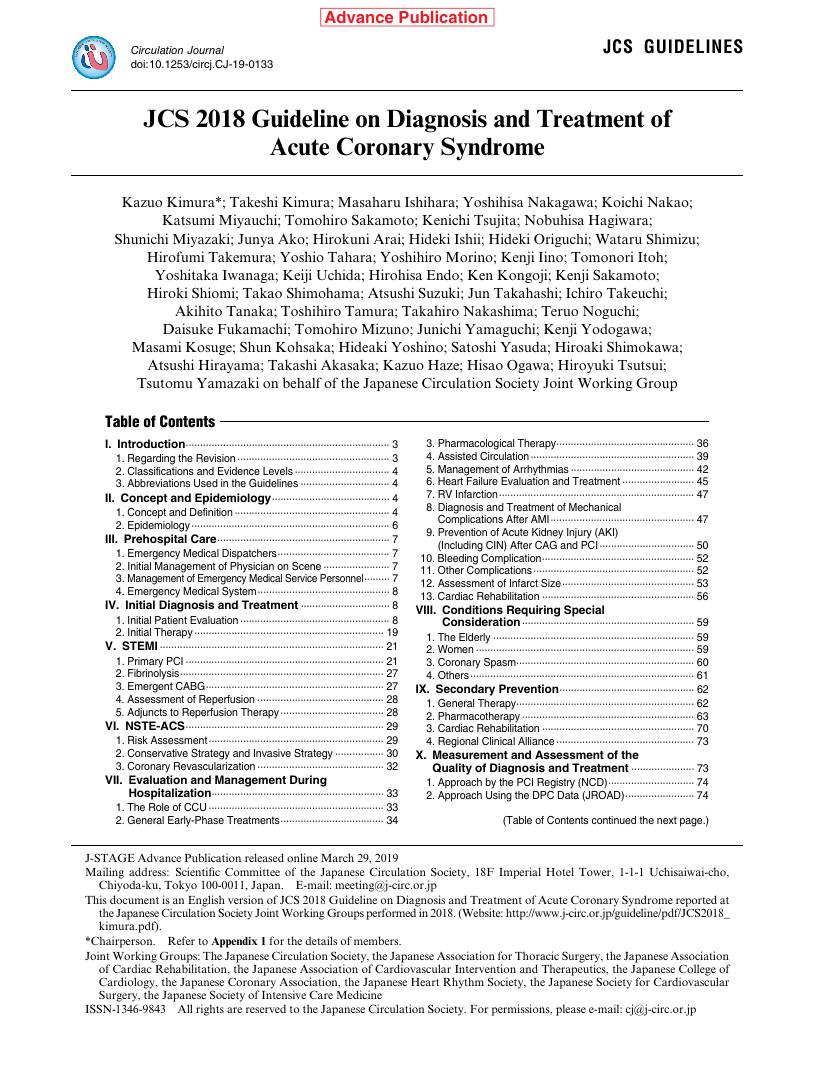- 著者
- Riku Arai Nobuhiro Murata Akimasa Yamada Suguru Migita Yutaka Koyama Tomoyuki Morikawa Shingo Ihara Naotaka Akutsu Tsukasa Kuwana Daisuke Fukamachi Kosaku Kinoshita Yasuo Okumura Hiroyuki Hao
- 出版者
- The Japanese Circulation Society
- 雑誌
- Circulation Reports (ISSN:24340790)
- 巻号頁・発行日
- vol.3, no.7, pp.419-420, 2021-07-09 (Released:2021-07-09)
- 被引用文献数
- 1
- 著者
- Masakazu Yamagishi Nagara Tamaki Takashi Akasaka Takanori Ikeda Kenji Ueshima Shiro Uemura Yutaka Otsuji Yasuki Kihara Kazuo Kimura Takeshi Kimura Yoshiki Kusama Shinichiro Kumita Hajime Sakuma Masahiro Jinzaki Hiroyuki Daida Yasuchika Takeishi Hiroshi Tada Taishiro Chikamori Kenichi Tsujita Kunihiko Teraoka Kenichi Nakajima Tomoaki Nakata Satoshi Nakatani Akihiko Nogami Koichi Node Atsushi Nohara Atsushi Hirayama Nobusada Funabashi Masaru Miura Teruhito Mochizuki Hiroyoshi Yokoi Kunihiro Yoshioka Masafumi Watanabe Toshihiko Asanuma Yuichi Ishikawa Takahiro Ohara Koichi Kaikita Tokuo Kasai Eri Kato Hiroshi Kamiyama Masaaki Kawashiri Keisuke Kiso Kakuya Kitagawa Teruhito Kido Toshio Kinoshita Tomonari Kiriyama Teruyoshi Kume Akira Kurata Satoshi Kurisu Masami Kosuge Eitaro Kodani Akira Sato Yasutsugu Shiono Hiroki Shiomi Junichi Taki Masaaki Takeuchi Atsushi Tanaka Nobuhiro Tanaka Ryoichi Tanaka Takuya Nakahashi Takehiro Nakahara Akihiro Nomura Akiyoshi Hashimoto Kenshi Hayashi Masahiro Higashi Takafumi Hiro Daisuke Fukamachi Hitoshi Matsuo Naoya Matsumoto Katsumi Miyauchi Masao Miyagawa Yoshitake Yamada Keiichiro Yoshinaga Hideki Wada Tetsu Watanabe Yukio Ozaki Shun Kohsaka Wataru Shimizu Satoshi Yasuda Hideaki Yoshino on behalf of the Japanese Circulation Society Working Group
- 出版者
- The Japanese Circulation Society
- 雑誌
- Circulation Journal (ISSN:13469843)
- 巻号頁・発行日
- pp.CJ-19-1131, (Released:2021-02-16)
- 参考文献数
- 1401
- 被引用文献数
- 49
- 著者
- Riku Arai Yasuo Okumura Nobuhiro Murata Daisuke Fukamachi Satoshi Honda Kensaku Nishihira Sunao Kojima Misa Takegami Yasuhide Asaumi Jun Yamashita Mike Saji Kiyoshi Hibi Jun Takahashi Yasuhiko Sakata Morimasa Takayama Tetsuya Sumiyoshi Hisao Ogawa Kazuo Kimura Satoshi Yasuda on behalf of the JAMIR Investigators
- 出版者
- The Japanese Circulation Society
- 雑誌
- Circulation Journal (ISSN:13469843)
- 巻号頁・発行日
- pp.CJ-23-0477, (Released:2023-11-23)
- 参考文献数
- 28
Background: This post hoc subanalysis aimed to investigate the impact of polyvascular disease (PolyVD) in patients with acute myocardial infarction (AMI) in the contemporary era of percutaneous coronary intervention (PCI).Methods and Results: The Japan Acute Myocardial Infarction Registry (JAMIR), a multicenter prospective registry, enrolled 3,411 patients with AMI between December 2015 and May 2017. Patients were classified according to complications of a prior stroke and/or peripheral artery disease into an AMI-only group (involvement of 1 vascular bed [1-bed group]; n=2,980), PolyVD with one of the complications (2-bed group; n=383), and PolyVD with both complications (3-bed group; n=48). The primary endpoint was all-cause death. Secondary endpoints were major adverse cardiovascular events (MACE), including cardiovascular death, non-fatal myocardial infarction, non-fatal stroke, and major bleeding. In the 1-, 2-, and 3-bed groups, the cumulative incidence of all-cause death was 6.8%, 17.5%, and 23.7%, respectively (P<0.001); that of MACE was 7.4%, 16.4%, and 33.8% (P<0.001), respectively; and that of major bleeding was 4.8%, 10.0%, and 13.9% (P<0.001), respectively. PolyVD was independently associated with all-cause death (hazard ratio [HR] 2.21; 95% confidence interval [CI], 1.48–3.29), MACE (HR 2.07; 95% CI 1.40–3.07), and major bleeding (HR 1.68; 95% CI 1.04–2.71).Conclusions: PolyVD was significantly associated with worse outcomes, including thrombotic and bleeding events, in the contemporary era of PCI in AMI patients.
- 著者
- Riku Arai Daisuke Fukamachi Masaki Monden Naotaka Akutsu Nobuhiro Murata Yasuo Okumura
- 出版者
- The Japanese Society of Internal Medicine
- 雑誌
- Internal Medicine (ISSN:09182918)
- 巻号頁・発行日
- vol.60, no.1, pp.79-83, 2021-01-01 (Released:2021-01-01)
- 参考文献数
- 14
- 被引用文献数
- 5
Ophthalmic carteolol is often used to treat glaucoma. Elderly patients with atrial fibrillation (AF) and chronic kidney disease (CKD) are common among the super-elderly in Japan. Because these patients are exposed to polypharmacy, they are at a high-risk of adverse drug interactions. We herein report an elderly patient with CKD who suffered bradycardia shock after the combined use of carteolol eye drops and verapamil for glaucoma and paroxysmal AF. This case highlights the fact that eye drops have a similar systemic effect to oral drugs, and especially in elderly patients with polypharmacy, drug interactions can unwittingly lead to serious events.
- 著者
- Kazuo Kimura Takeshi Kimura Masaharu Ishihara Yoshihisa Nakagawa Koichi Nakao Katsumi Miyauchi Tomohiro Sakamoto Kenichi Tsujita Nobuhisa Hagiwara Shunichi Miyazaki Junya Ako Hirokuni Arai Hideki Ishii Hideki Origuchi Wataru Shimizu Hirofumi Takemura Yoshio Tahara Yoshihiro Morino Kenji Iino Tomonori Itoh Yoshitaka Iwanaga Keiji Uchida Hirohisa Endo Ken Kongoji Kenji Sakamoto Hiroki Shiomi Takao Shimohama Atsushi Suzuki Jun Takahashi Ichiro Takeuchi Akihito Tanaka Toshihiro Tamura Takahiro Nakashima Teruo Noguchi Daisuke Fukamachi Tomohiro Mizuno Junichi Yamaguchi Kenji Yodogawa Masami Kosuge Shun Kohsaka Hideaki Yoshino Satoshi Yasuda Hiroaki Shimokawa Atsushi Hirayama Takashi Akasaka Kazuo Haze Hisao Ogawa Hiroyuki Tsutsui Tsutomu Yamazaki on behalf of the Japanese Circulation Society Joint Working Group
- 出版者
- The Japanese Circulation Society
- 雑誌
- Circulation Journal (ISSN:13469843)
- 巻号頁・発行日
- pp.CJ-19-0133, (Released:2019-03-29)
- 参考文献数
- 1064
- 被引用文献数
- 31 314
- 著者
- Daisuke Fukamachi Hiroyuki Hao Suguru Migita Naotaka Akutsu Yoshiaki Kusumi Yasuo Okumura Atsushi Hirayama
- 出版者
- The Japanese Circulation Society
- 雑誌
- Circulation Reports (ISSN:24340790)
- 巻号頁・発行日
- vol.1, no.11, pp.538-539, 2019-11-08 (Released:2019-11-08)

